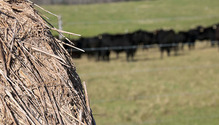Adjust feeding strategies when temps drop |
| By Hay and Forage Grower |
|
|
|
When the bite of winter takes hold, forage intake can rise by 30 percent. Beef animals use most of this additional intake to meet the higher maintenance requirement imposed by colder temperatures, according to Kim Mullenix, Auburn University’s extension beef specialist. “Cattle with a full rumen generate heat and energy that can help the animal achieve a more desirable body temperature,” Mullenix says. “But forage quality plays an important role. Depending on the quality of the forage and the magnitude of the cold, hay alone may or may not meet the animal’s higher energy requirement,” she adds. Though forage consumption rises during cold weather, feeding only low-quality forage that is less than 52 percent total digestible nutrients (TDN) will not meet the cow’s energy requirements. Mullenix notes that as animals consume larger amounts of low-quality hay, compaction of the digestive tract can occur. “If low-quality hay is the only source available, it is important to provide a fiber-based energy supplement such as soyhulls, corn gluten feed, and whole cottonseed to help address nutrient deficiencies,” Mullenix said. The best approach to meet the higher energy needs is to provide free-choice, moderate to good-quality hay that is over 52 percent TDN. Mullenix also suggests boosting any energy supplement by 20 to 30 percent during cold, wet weather. As an additional suggestion, Mullenix says to provide feed in late afternoon or early evening. “Heat production by the animal occurs four to six hours after consumption. Therefore, provide feed before temperatures reach their lowest point for the day,” she says. Limit-grazing The growth of fall-planted, winter-annual cereals slows as temperatures drop. Mullenix says livestock producers must remember to manage this forage resource for the long haul. “Grazing winter-annual forages when growth is tempered by cold can easily lead to overgrazing,” Mullenix says. “If this occurs, growth will be delayed once warmer temperatures return. Further, stand life may be compromised,” she adds. Once forage growth ceases, remove cattle from winter-annual pastures until warmer temperatures return. At that point, Mullenix suggests limit-grazing livestock. This involves moving animals onto high-quality, cool-season pasture for a short period of time (three to four hours), then moving them back to a drylot and providing access to hay or stockpiled perennial forage. According to the Auburn beef specialist, limit grazing accomplishes two things. It conserves hay inventories and also may improve the digestibility of dry hay by improving the rumen fermentation environment. Limit-feeding hay Some beef producers choose to stretch hay supplies by limiting the time animals have access to the feeder or reducing the amount of hay that is actually fed. “Limit-feeding hay is not a recommended practice during extreme weather conditions,” Mullenix warns. “Animals need free-choice access to hay during periods of environmental stress. Once temperatures moderate, limit-feeding hay may be an option when using mid- to high-quality forage. It’s not a beneficial practice if low-quality forage is being offered to cows,” she adds.
As we enter the dog days of winter, feeding strategies won’t be the same for every farm or ranch; however, it’s likely that ration adjustments will need to be made on most operations. What those adjustments will be hinge largely on the quality of forage being offered. |

